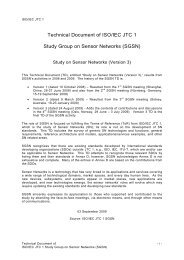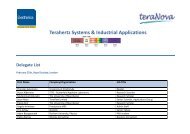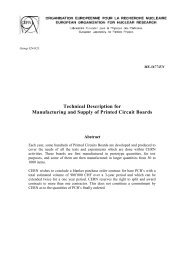Self-Timed SRAM for Energy Harvesting Systems - Electronics ...
Self-Timed SRAM for Energy Harvesting Systems - Electronics ...
Self-Timed SRAM for Energy Harvesting Systems - Electronics ...
Create successful ePaper yourself
Turn your PDF publications into a flip-book with our unique Google optimized e-Paper software.
dled data methods based on delays. Noting that the delay of inverter chains commonly<br />
used in conventional <strong>SRAM</strong> to generate required timings <strong>for</strong> precharge and data access<br />
phase hardly match all the timing variations of the bit line activities across a wide<br />
range of supply voltages [11,12], the authors of [9] used a duplicated column of memory<br />
cells to replace inverter chains to serve as delay elements. Although in theory this<br />
offers potentially correct delay matching <strong>for</strong> memory under variable Vdd, so long as<br />
process variation [3] is kept under control, the method requires voltage references <strong>for</strong><br />
precharge and sensing data. The voltage reference is assumed to be adjustable to accommodate<br />
the process, voltage, and temperature conditions.<br />
In summary, most of existing solutions work under worst case timing assumptions,<br />
and some of them also require adjustable and known reference voltages. However, in<br />
the energy harvesting environment, there may not be stable reference voltages in a<br />
system at all, so anything based on comparators will not work. All voltages in the<br />
system may be non-deterministic. All delays may there<strong>for</strong>e be non-deterministic.<br />
3 Investigation on <strong>SRAM</strong> cells in terms of latency<br />
<strong>SRAM</strong> memory is constructed from <strong>SRAM</strong> sells, address decoders, precharge driver,<br />
write driver, read driver, and controller. Although there exist different structures of<br />
<strong>SRAM</strong> cells, here we only focus on the simplest 6T [15] cell which offers the best<br />
prospect <strong>for</strong> use in energy harvesting systems.<br />
Normally memory works based on timing assumption. However, energy harvesting<br />
systems work under a wide range of non-deterministic power. It is necessary to know<br />
how timing assumptions are affected under different Vdds.<br />
Here we investigate the difference between the latency on bit line drive and its corresponding<br />
typical inverter-chain delay elements used in controllers under different<br />
Vdds. This potential mismatch has already been pointed out in papers [11,12]. [11]<br />
concludes that the latency on inverter chains are getting worse and worse along with<br />
reducing the Vdd. [12] concludes that the percentage of the bit line drive time of the<br />
total access time under reducing Vdds is getting bigger and bigger. But do both types<br />
of delays increase at the same rate under the same Vdd reduction rate<br />
To emphasize the mismatch, we directly show the difference between the reading/writing<br />
times and the latency of delay elements in various Vdds in the right hand<br />
side of Figure 1.<br />
start<br />
<strong>SRAM</strong><br />
finish<br />
Figure 1 Investigation on delay elements in various Vdd: Block diagram (left)<br />
and Results (right).<br />
The experiment bundles an <strong>SRAM</strong> cell with an inverter chain, with both operating<br />
under the same variable Vdd as shown in the left hand side of Figure 1. A start signal
















